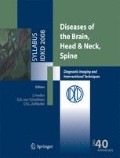Abstract
Head and neck squamous cell carcinoma (HNCC) is the sixth most common cancer worldwide. Accurate staging is crucial for therapy planning. Patients with small tumors and without nodal and distant metastases (T1/T2N0M0) have a good chance to be cured. Nodal metastases or distant metastases at initial presentation worsen the prognosis significantly. Because alcohol and nicotine abuse are important risk factors for head and neck cancers, these patients often develop second primaries, especially in the upper aerodigestive tract (up to 5–10% of cases). PET and PET/CT play an emerging role in staging of patients with HNCC. FDG-PET/CT is increasingly used for radiation therapy planning in combination with intensity-modulated therapy (IMRT). Nearly all PET/CT studies in patients with HNCC involve the use of FDG, which is the focus of this article.
Access this chapter
Tax calculation will be finalised at checkout
Purchases are for personal use only
Preview
Unable to display preview. Download preview PDF.
References
Goerres GW, Von Schulthess GK, Hany TF (2002) Positron emission tomography and PET CT of the head and neck: FDG uptake in normal anatomy, in benign lesions, and in changes resulting from treatment. AJR Am J Roentgenol 179:1337–1343
Yeung HW, Grewal RK, Gonen M et al (2003) Patterns of (18)F-FDG uptake in adipose tissue and muscle: a potential source of false-positives for PET. J Nucl Med 44:1789–1796
Popperl G, Lang S, Dagdelen O et al (2002) Correlation of FDG-PET and MRI/CT with histopathology in primary diagnosis, lymph node staging and diagnosis of recurrency of head and neck cancer. Rofo 2002; 174:714–720 [German]
Schoder H, Yeung HW, Gonen M et al (2004) Head and neck cancer: clinical usefulness and accuracy of PET/CT image fusion. Radiology 231:65–72
Adams S, Baum RP, Stuckensen T et al (1998) Prospective comparison of 18F-FDG PET with conventional imaging modalities (CT, MRI, US) in lymph node staging of head and neck cancer. Eur J Nucl Med 25:1255–1260
Schwartz DL, Rajendran J, Yueh B et al (2003) Staging of head and neck squamous cell cancer with extended-field FDG-PET. Arch Otolaryngol Head Neck Surg 129:1173–1178
Schwartz LH, Ozsahin M, Zhang GN et al (1994) Synchronous and metachronous head and neck carcinomas. Cancer 74:1933–1938
Rusthoven KE, Koshy M, Paulino AC (2004) The role of fluorodeoxyglucose positron emission tomography in cervical lymph node metastases from an unknown primary tumor. Cancer 101:2641–2649
Lowe VJ, Dunphy FR, Varvares M et al (1997) Evaluation of chemotherapy response in patients with advanced head and neck cancer using [F-18]fluorodeoxyglucose positron emission tomography. Head Neck 19:666–674
Klabbers BM, Lammertsma AA, Slotman BJ (2003) The value of positron emission tomography for monitoring response to radiotherapy in head and neck cancer. Mol Imaging Biol 5:257–270
Goerres GW, Schmid DT, Bandhauer F et al (2004) Positron emission tomography in the early follow-up of advanced head and neck cancer. Arch Otolaryngol Head Neck Surg 130:105–109
Lowe VJ, Boyd JH, Dunphy FR et al (2000) Surveillance for recurrent head and neck cancer using positron emission tomography. J Clin Oncol 18:651–658
Ciernik IF, Dizendorf E, Baumert BG et al (2003) Radiation treatment planning with an integrated positron emission and computer tomography (PET/CT): a feasibility study. Int J Radiat Oncol Biol Phys 57:853–863
Davis JB, Reiner B, Huser M et al (2006) Assessment of 18F PET signals for automatic target volume definition in radiotherapy treatment planning. Radiother Oncol 80:43–50
El-Bassiouni M, Ciernik IF, Davis JB et al (2007) [18FDG] PET-CT-based intensity-modulated radiotherapy treatment planning of head and neck cancer. Int J Radiat Oncol Biol Phys 69:286–293
Rothschild S, Studer G, Seifert B et al (2007) PET/CT staging followed by Intensity-Modulated Radiotherapy (IMRT) improves treatment outcome of locally advanced pharyngeal carcinoma: a matched-pair comparison. Radiat Oncol 2–22
Author information
Authors and Affiliations
Editor information
Editors and Affiliations
Rights and permissions
Copyright information
© 2008 Springer-Verlag Italia
About this chapter
Cite this chapter
Strobel, K. (2008). PET/CT Staging and Restaging of ENT Tumors, Pitfalls. In: Hodler, J., Von Schulthess, G.K., Zollikofer, C.L. (eds) Diseases of the Brain, Head & Neck, Spine. Springer, Milano. https://doi.org/10.1007/978-88-470-0840-3_39
Download citation
DOI: https://doi.org/10.1007/978-88-470-0840-3_39
Publisher Name: Springer, Milano
Print ISBN: 978-88-470-0839-7
Online ISBN: 978-88-470-0840-3
eBook Packages: MedicineMedicine (R0)

